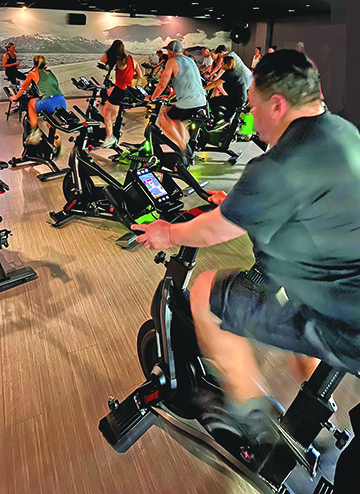
by Glendale Sports Center | Jul 20, 2023 | Glendale City News
Discovering Life Lessons Through The Lens Of Fitness
by Claudia Morlan, YMCA of Metro Denver

Cycling class at the Arvada YMCA.
When Victoria Cardenas came to Denver from Mexico City in 1997, there were two things she wanted to learn how to do. The first was to ride a bike, which she learned from her husband Francisco Cardenas. The second was how to swim, a skill she gained through swim lessons at her local YMCA.
More than two decades later, Victoria is still using and enjoying both activities. She runs, bikes, and swims in triathlons, thanks to the same two people who encouraged her in the first place: Francisco and Elizabeth “Liz” Bravman, nutritionist and cycling instructor at the Arvada YMCA.
Every Thursday from 9 to 10 a.m., there’s a good chance you’ll find Victoria and Francisco pedaling in Liz’s cycling class, getting both sweaty and inspired. Francisco and Victoria have been members of the Y since 2001, and it was at the downtown Denver YMCA where Victoria learned to swim. Today, they frequent the Arvada-Ducan Y just a few minutes from their home.
“I went back to cycling about six months ago after I had gained some weight, and Liz Bravman at the Y has made all the difference,” said Francisco. “Liz is kind, giving, supportive and knowledgeable.”
“Liz is amazing. Go take a class with her and you’ll see how motivating and supportive she is,” echoed Victoria. “In class, Liz instructs us to set goals for ourselves and then gives us the motivation and encouragement to reach those goals. This is a great lesson to apply to my day-to-day schedule — set simple, achievable goals, and then enjoy the satisfaction of achieving them.”
As she sets goals for her students, Liz draws upon her own experience as a former Y student.
“Before I became a Y cycling instructor and nutritionist, I belonged to the Y, using my membership for its fantastic childcare and to improve my health,” recalled Liz.
As a mother of three, the Y became a “third place” for Liz, a bridge between home and her children’s school for workouts, stress relief, and opportunities to connect with others socially.
Now that she is an instructor, Liz’s approach is to “let [my students] know they are in control of everything in cycling class, including their goals, effort, and attitude. I always encourage people to find a small challenge for each day and try meet those challenges.”
“Our fellow students are awesome too,” Victoria added. “There’s no judgement, and we are supportive of each other — it’s not like a recreation center or fitness club where people just look down while they exercise and try to get out without interacting with another person.”
Francisco also noted the class camaraderie and support. “Liz sets an environment where everyone is welcome regardless of ability. She plays a killer variety of music including hip hop, classic rock, and even a little country. I work out harder in a group environment, and because cycling is a low-impact exercise, I don’t have any issues with my joints or ligaments, like I did when I ran.”
According to Francisco and Victoria, classes with Liz are not just about fitness. They are about taking the lessons and motivation from the exercise classroom and applying them to life.
“Both Victoria and I have gained so many benefits from Liz’s cycling class — physically, emotionally. When we go to the Y, we eat better, our days are better, we smile more, and I’m a kinder person,” said Francisco.
Liz sees these lessons as key motivations and benefits of cycling. “Cycling class is a metaphor for life: How we push ourselves inside and outside of class. Cycling transcends physical and mental challenges. I’s very empowering to move your body. Everybody should try it. It’s low impact and good on the joints, and you’re never too young or too old to cycle. You can push yourself as hard as you want.”
Indoor cycling is available at the Arvada, Aurora, Littleton, Southwest, and University Hills YMCAs. Learn more about the YMCA’s cycling and other exercise offerings at den verymca.org or the Meet & Cycle classes at the Glendale Sports Center at Infinity Park at sportscenterglendale.com.
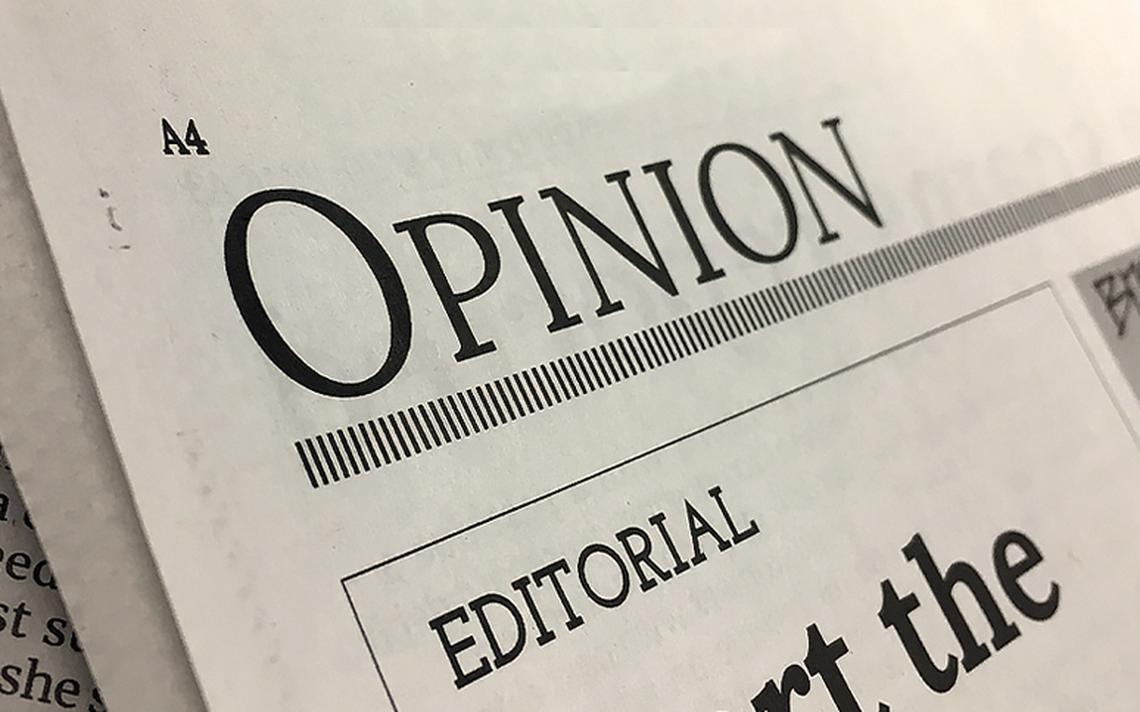
by Charles Bonniwell | Jul 20, 2023 | Editorials
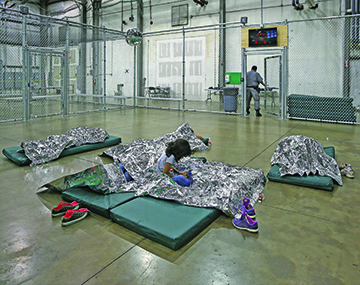
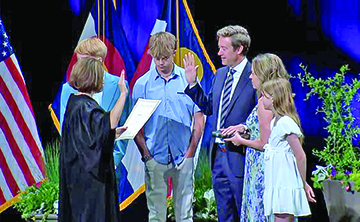
Mike Johnston is sworn in as the 46th Mayor of Denver on July 17, 2023.
Although the Biden Administration may dispute it, most people would view seven million people illegally crossing the United States southern border in the last several years as a financial disaster. That does not mean that there is not a lot of money to be made from it. Certainly, the Mexican drug cartel bringing fentanyl and other drugs, the coyotes smuggling in illegal immigrants, the nonprofit groups sheltering the immigrants once they cross, and the federal contracts paid to disburse them throughout the country; all are doing very well indeed.
Denver has absorbed only a small fraction of the recent immigrants with Denver officials estimating approximately 1,200 at any one time with the cost estimated to be up to $1,000 per immigrant per week (an estimated $17 million total). The immigrants have been housed in recreation centers and anywhere else space could be found.
The Hancock Administration in its final days wanted to burden the new Johnston administration with a one-year contract with GardaWorld Federal Services to operate a single 1,000-person shelter with intake services, food, and transportation for $40 million.
Denver’s nonprofit world went bonkers. They screamed about the city of Denver hiring a Canadian detention company with an awful record of waste and abuse when they could provide an equal amount of waste and abuse with money staying right here in Denver. Sometimes people fail to comprehend that “nonprofit” is simply a federal tax status and the people running them are every bit as rapacious and money hungry as their counterparts in the for-profit world.
At $40,000 per immigrant, per year, there is plenty of gravy to go around, especially considering that many more shelters will probably be needed and for an indefinite period of time. Moreover, the educational and health needs of every immigrant will also need to be provided.
Luckily, our new mayor Mike Johnston has indicted that he can solve all these problems, as well as the indigenous homeless quagmire, all in a single year with his tiny homes and other programs. Previous mayor, now Senator, John Hickenlooper had promised he would end homelessness in a decade, but later said that was just sales puffery for the always gullible Denver residents.
With Mike Johnston being sworn in on July 17, 2023, it is exciting to know that all these problems, some of which have plagued mankind since civilization began, will be solved in less than one year. In the meantime, don’t you be handing out any lucrative contracts. Keep the largesse right here in Denver, on the off chance that the problems might go on slightly past July 16th of 2024.
— Editorial Board
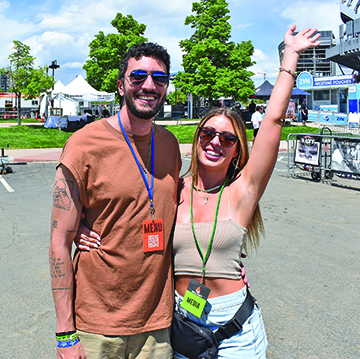
by Mark Smiley | Jun 23, 2023 | Travel
by Mark Smiley
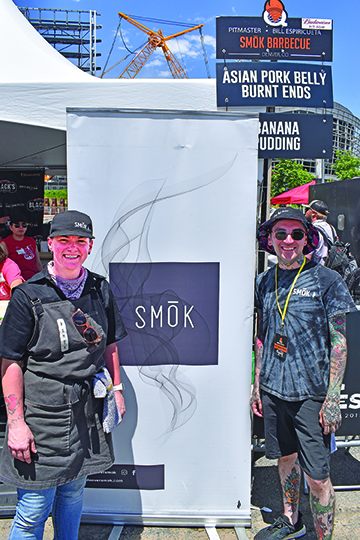
Local Favorite: Bonnie Hammontree, left, and Mickey Telles, General Manager Smōk Denver, served Asian pork belly burnt ends and their famous banana pudding at the 2023 Denver BBQ Fest.
The Denver BBQ Fest held its annual event over Memorial Day weekend this year as thousands of BBQ enthusiasts came to enjoy BBQ from pitmasters from around the world at Empower Field. This year’s event shifted to a ticketed venue making the crowd more manageable and allowed the pitmasters to prepare for a more precise amount.
Some of the returning pitmasters included Pappy’s Smokehouse, Ubons Barbecue, Black’s BBQ, and hometown favorites GQue BBQ and Sugarfire Smokehouse. New local restaurants were also on hand to dish out their well-known dishes including Smōk Denver which is located at The Source Hotel & Markethall.
Smōk Denver will celebrate its 5th anniversary in August 2023. They served Asian pork belly burnt ends and their famous banana pudding in the booth next to Black’s Barbecue, a renowned BBQ from Central Texas. Smōk Denver features a hybrid of Kansas City and Texas style barbecue with Kansas City style rubs and Texas style smokes. Smōk Denver uses a post oak wood to give it the Texas style smoke which is a cleaner and lighter smoke so they can add what they want to it and not overpower the meat. “We want the meat to talk for itself rather than what we have going on underneath it,” said Mickey Telles, General Manager Smōk Denver. “We want the flavor to be set there but we want you to feel that meat.”
The flavor was front and center at the fest and introduced attendees who may not have normally been familiar to their BBQ. This was Smōk Denver’s first BBQ Fest and the largest event they have ever done as a team. “It’s been great,” said Telles. “It’s been an incredible amount of fun and the staff here has been fantastic at taking the anxiety of setting everything up away. It has been smooth sailing.”
In addition to serving their popular dishes, they learned a little from other pitmasters along the way. “It’s nice to meet people and see how they’re doing it,” said Telles. “BBQ is cooked meat but everyone does it differently. Any slight change anybody puts on that creates a different product. It’s interesting to see how everyone else does it.”
Smōk Denver was started by Bill Espiricueta who was born in Austin, Texas, and has enjoyed BBQ from an early age. “Our pitmaster Bill [Espiricueta] is the reason all of us are here,” said Telles. “He has been around the food industry for quite awhile and came from Kansas City. We found a really good spot up in the Source Market and thought that was a really good spot to go for it. We have been chugging along ever since.”
Smōk Denver is located at The Source Hotel & Markethall at 3330 Brighton Blvd. in Denver. Visit www.denversmok.com for more information. Mention this article and receive a 20% discount on your order.
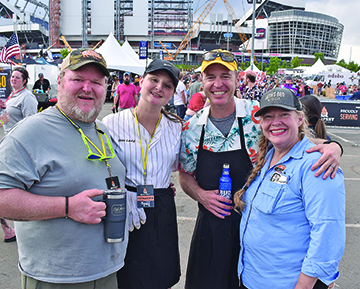
Pitmasters: Shane McBride, Pig Beach BBQ; Erin Campbell, Ubons Barbecue; Jason Ganahl, GQue BBQ; and Leslie Roark Scott, Ubons Barbecue, celebrate another successful BBQ Fest in the mile high city.
The Denver BBQ Fest is not about winning awards or competition. It is about serving great BBQ in a friendly and collaborative atmosphere. Six days prior to the fest, Shane McBride, Pitmaster, Pig Beach BBQ from New York and Florida, won an important competition in Memphis.
Ribdiculous Bar-B-Krew earned the coveted title of Grand Champion of the Memphis in May World Championship Barbecue Cooking Contest on May 20, 2023. It was the first time in 21 years that a rib team had won. They received a rare perfect score in the preliminary round. “I cried for hours,” said McBride. “Any picture you see, I have tears in my eyes.”
McBride started making BBQ professionally in 2008 and has enjoyed running his business, Pig Beach, in New York and Florida ever since. He enjoys coming to Denver and was in a relaxed mood after winning the Grand Championship. “It’s a great festival [Denver BBQ Fest],” said McBride. “To sit and cook BBQ steps away from a beautiful football stadium in a legendary football town, it’s pretty awesome.”
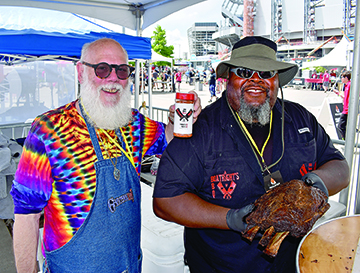
Baby Back: Joebaby Michaels, Bent River Records, left, and James Boatright, Boatright’s BBQ, show off the baby back ribs served in the VIP area that had guests smacking their lips.
He has advice for the backyard enthusiast. “The number one thing about BBQ is patience,” said McBride. “It’s not something you can rush. Whether you’re cooking a chicken to a whole hog, it’s patience. You also have to rest your meat. It’s all about time management, patience, and resting.”
Advice also rolled in from James Boatright, Pitmaster of Boatright’s BBQ, St. Louis, Missouri. “A lot of pitmasters put information out on Youtube,” said Boatright. “I would say don’t be intimidated by that. More than anything, keep it simple and pay attention to time and temperature. A lot of people get in a rush and want to make it look like Boatright’s BBQ. Take your time and make simple BBQ and enjoy your family and friends.”
Boatright’s served Beef short ribs in the VIP area of the festival. Boatright joked, “Nothing against the other pitmasters, they’re great. But they [guests] said I was the best so far. When the people speak, you listen.”
The people definitely spoke and enjoyed Boatright’s attention to seasoning and flavor. He prides himself on doing things just a little bit differently. “Anything you do, you can’t be one dimensional,” said Boatright. You have to think outside the box and I believe in challenging myself with flavor profiles and building layers. I like to keep it simple and have people’s tastebuds happy. Keep it real and put some love into it, you can’t go wrong.”
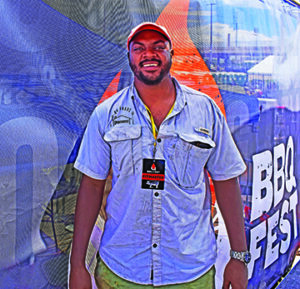
Caribbean Flavors: Johann Callender, Pitmaster, Barbados Smokehouse, was the first International pitmaster invited to BBQ Fest.
Boatright has been a fan of BBQ his entire life. “I have been doing this since I was knee high to a grasshopper,” said Boatright. “My first memory of BBQ was watching my dad dig a hole in the ground. I was about five years old and he put the whole hog in the

Happy Attendees: Denver BBQ Fest was a ticketed event this year and held over Memorial Day weekend.
ground and I was blown away with it. Ever since, I have been fascinated with it.”
Boatright started his professional career in 2015. Readers may remember him from the popular Netflix show, Barbecue Showdown. Follow Boatright on Facebook and Instagram @boatrightsbbq He is also a singer and his latest song called “I Can Take You Further” can be found on Spotify and other platforms.
Johann Callender, Pitmaster, Barbados Smokehouse, came the furthest to participate in this festival. Callender has been a pitmaster for four years and last year, he was here on a program in conjunction with the U.S. State Department. He was invited this year to be the first International pitmaster at Denver BBQ Fest. There are not many options for BBQ in Barbados so Callender started out catering small events and took off from there.
They served Smoked Flash Fried Chicken with a Caribbean twist and pimento wood smoked jerk lamb at his tent. “We wanted to bring a very Caribbean known dish,” said Callender. “We used a lot of pimento, cilantro, green onion, and garlic. Everyone seems to be super happy with the food. We have smoked over 600 pounds of lamb this weekend.”
Follow them on Instagram @barbadossmokehouse and be sure to visit if you travel to the island.
Woodhill Small Batch BBQ, another local participant who runs a food truck and catering business, served brisket, macaroni salad, and Woodhill twinkies this year. “The twinkies this year came about because the first year that we did this, I was doing the twinkies and serving them out the back door for the super special people,” said Jodi Segura, owner of Woodhill Small Batch BBQ. “That was a massive hit and I think because it was such a hit, they had me do them for everyone this year. I did over 1,400 of them the last two days.”

Family Owned: Keith and Jodi Segura, Woodhill Small Batch BBQ, are available to book for weddings, events, and catering. They are a local and family owned and operated business serving BBQ that rivals any from Texas, Kansas City, or St. Louis.
Woodhill Small Batch BBQ is family owned and operated by Keith and Jodi Segura. They won best BBQ restaurant back-to-back years in Castle Rock as well as best food truck in Castle Rock last year and Lone Tree this year. They pride themselves on a family first approach and although they are available to cater your event, they do not sacrifice being a part of their high school son’s activities.
That family first approach resonates with the food they prepare and the price point in which they charge for it. “I want people to understand we are a local company where families can come eat at our trailer at a reasonable price and have a great enjoyable meal,” said Segura. “I want people to realize that BBQ is great here in Colorado. It isn’t just St. Louis and Texas. We are trying to make a name for BBQ and make BBQ great in Colorado.”
Visit www.woodhillbbq.com for more information, where to find their truck or to book for your next event or catering.
BBQ Fest will return in 2024. For more information and updates, visit www.qbbqdenver.com.

by Mark Smiley | Jun 23, 2023 | General Featured
Tech Infused Mini Golf Venue With An Elevated Food And Drink Menu Opens In The River North Art District
by Mark Smiley

Course Hero: Puttshack is an upscale, tech-infused mini golf experience where the screens will guide you through the game.
Puttshack opened Colorado’s first location in Denver’s River North Art District on May 26, 2023. Puttshack is a tech infused indoor mini golf entertainment facility that features an elevated food and beverage menu.
“There is a global inspiration in the menu and lots of shareables where people are trying different things,” said Susan Walmesley, Chief Marketing Officer, Puttshack. “Almost all of it is cooked from scratch in our kitchen.”
Puttshack has nine locations in the U.S. and four in the U.K. with plans for more by the end of the year. The concept, originated in London by Topgolf inventors Steven and Dave Jolliffe, opened its first location in 2018, and the first in the U.S. in 2021.
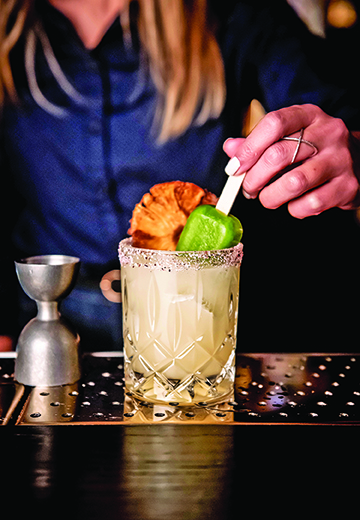
Margarita: The spiced pineapple mezcal margarita is served with a Jalapeño Hellfire Popsicle and a candied pineapple wafer.
The core demographic are ages 21-35 with disposable income and time that are looking for new experiences. “Denver was way up there on our list of places we wanted to get into,” said Walmesley. “This is a really vibrant neighborhood with our core demographic close by.”
Although Puttshack caters to the younger crowd at night complete with DJs on the weekends, they welcome families during the day to experience this new way to play mini golf. It is tech infused where the technology is in the golf ball and it tracks every one of your shots. The patented Trackaball™ technology allows guests to play a point scoring game that does not allow cheating. There are four courses to choose from and all can be booked online.
“So much fun,” said Laura M. on Yelp. “We took a group of seven there for putt putt, dinner, and drinks, and ended up doing another round after dinner. We did Amber and Emerald, and while we enjoyed both, we thought Emerald was a blast. The putt putt was so much fun, and the hole designs were so cool.”
Puttshack has experienced a steady flow of guests in its first month and hopes to book more private parties in the coming months. “We are going to take it slow,” said Jake Wise, Director of Operations, Puttshack Denver. “We want to get off on a good footing and deliver what our guests expect. They are the ones coming out to spend money and we want to be the answer to ‘where should we get together.’ We are going to do our best to execute great food and amazing beverages. We are the only tech infused mini golf in the world.”
Puttshack Denver is located at 2813 Blake Street in Denver. You can book online at www.puttshack.com/locations/denver. Follow them on Facebook @puttshackdenver and on Instagram @puttshack.
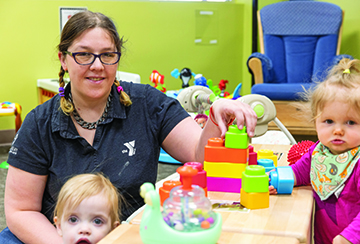
by Glendale Sports Center | Jun 23, 2023 | Glendale City News
by Julie Cataldo, Sr. Director,  Early Childhood Education,
Early Childhood Education,
YMCA of Metro Denver
As Denver grows and Colorado prepares to launch universal preschool, more families than ever are looking for early childcare/education for the fall. The task can seem daunting, but the key is to find a safe and nurturing option that draws out kids’ interests and encourages them in a fun, welcoming, and creative learning environment. Just ask Christina Graham, who has worked at the YMCA University Hills Academy Preschool for nine years. As someone who discovered a love for music early in her own life, Graham is delighted with the opportunity to bring rhythm and melody into the classroom.
“I sing every day — have a song for every occasion,” she shared. “Learning through music for me always stuck more and was more enjoyable. It makes learning more fun.”
Graham is the lead teacher of the Preschool room at University Hills Y Academy, the first preschool class for children 2.5-4 years old. She teaches foundational concepts like shapes, numbers, and the alphabet to about 20 kids.
“We use Creative Curriculum that gives us a deep dive into different subjects,” she shared “One month we focus on water, and the next month we will focus on the concept of building things.”
Exploration is a cornerstone of Y Academy curriculum and an element that Graham particularly appreciates. There is never a dull moment in Graham’s classroom. From making oobleck, trying yoga, and holding their own dance parties, to learning about reptiles and magic tricks, every week holds a new discovery.
“We have a music center, a block center, and a science center. We teach a lot through play and seeing what the children’s focus is on,” Graham explained. “At this young age, having many opportunities to try new things is key to discovering what you like. You can try basketball, swimming, soccer, and piano classes — all that at such a young age. That is an important opportunity, and I’m really glad we can do that for the community and the kids.”
Having that strong, nurturing community is key too.
“I really like how close we can get with the families. We have families whom I have taught all of their kids, and now their nieces and nephews are coming through as well,” Graham added. “You get to connect and grow with them.”
Graham and her fellow Academy teachers prioritize developing connections with parents and help them stay connected daily through the Y’s “Tadpoles” program, where they can provide an outline of what kids are doing and send pictures and updates throughout the day. The Y Academy teachers also offer simple activities that parents can do to further classroom learning at home.
For instance, Graham “shares the teaching-based songs we are learning with parents, so they sing them at home with their kids.”
Graham has certainly seen the results of this play-based, community-centered learning at the Y. Academy teachers use Teaching Strategies Gold as an assessment tool, which includes photos of assignments over time. Graham shared that she has “some kids who could barely write at the beginning of the year and can clearly spell their name by the end. It’s really fun to see the improvement and celebrate with them as they are getting better and know it too.”
The YMCA of Metro Denver offers three early childhood education centers around the metro area — Arvada, Southwest, and University Hills — as well as programs like swim lessons, youth sports, dance classes, before and after school enrichment programs, and more through school age and beyond. Learn more about all the programs the YMCA has to offer at denverymca.org.

by Charles Bonniwell | Jun 23, 2023 | Editorials
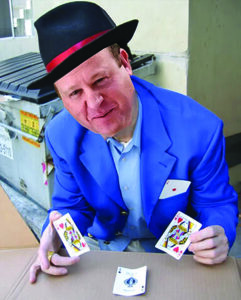 Your property taxes will be going sky high after Governor Polis and a bi-partisan majority in legislature convinced us voters in 2020 to do away with the Gallagher Amendment which limited property tax hikes for homeowners. The Gallagher Amendment saved homeowners $82 billion in taxes since its adoption in 1982. But no more.
Your property taxes will be going sky high after Governor Polis and a bi-partisan majority in legislature convinced us voters in 2020 to do away with the Gallagher Amendment which limited property tax hikes for homeowners. The Gallagher Amendment saved homeowners $82 billion in taxes since its adoption in 1982. But no more.
Having suckered voters so successfully last time, Governor Polis has come up with another POLIS con job, Proposition HH. This will go before the voters in the fall. This time it is being done without Republican connivance, but Republican opposition may no longer matter. Rushed through at the end of the session, the Democrats in the legislature closed all debate, causing Republicans to walk out.
Proposition HH appears to have drawn inspiration from the old confidence man’s three-card monte card trick. In that card game you are supposed to pick out the black ace from three cards. Trick of hand makes sure you never do. In Proposition HH the voters are supposed to pick out the tax relief but by sleight-of-hand language you are voting yourself a “tax raise.”
If you vote “Yes” on Proposition HH you may think you are getting property tax relief from the effects of the revocation of the Gallagher Amendment, but you have not followed the cards closely enough. While your property tax will be slightly reduced for 10 years you would allow the state to keep more of your Tabor refunds permanently with a portion going to favored entities to backfill what they would lose from the slight reduction in property tax rates over the 10 years. Without going into all the byzantine meandering of the proposition, you are, in effect, voting yourself a tax raise under the guise of “tax relief.”
The governor has always been something of a flimflam man, but he has proven it works. His real name was Jared Shutz, but he changed it before going into public life to hide some of the more unsavory parts of his past, in particular, an assault on a female employee. He pushed the Colorado Independent Ethics Commission idea as an effort to promote confidence in our government institutions when it is perhaps the greatest bureaucratic con job in all of Colorado government.
He has promoted himself nationally as a Democrat who is also something of a small “l” libertarian, which is comical, but the national press is dutifully calling him by that description. Reason Magazine recently wrote an article on him titled “Jared Polis: The Most Libertarian Governor in America?” He is considered by some as the leading candidate for the Democratic nomination for U.S. President should Joe Biden pull out for some reason.
Will his three-card monte trick called Proposition HH fool the voters? If the past is any indication, don’t bet against Polis as the dealer.
— Editorial Board















